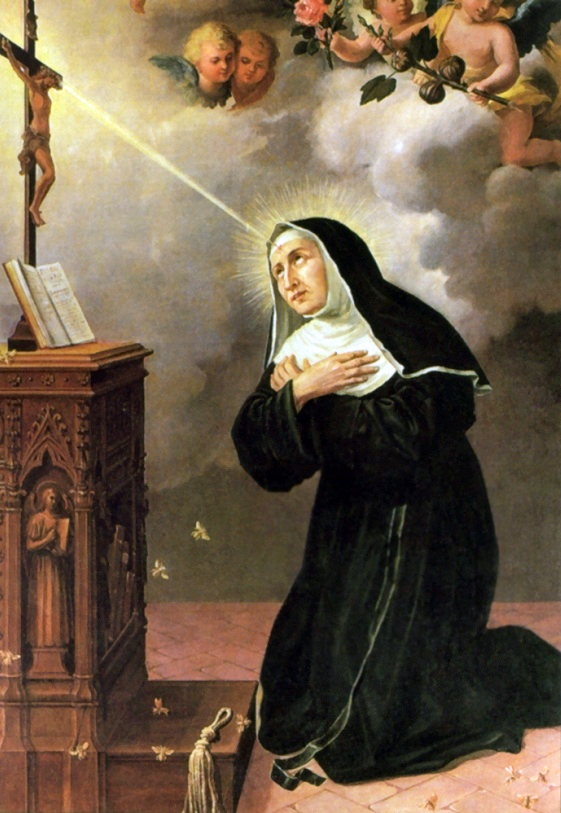Known as the patron saint of the impossible and model of maidens, wives, mothers, widows and nuns, St. Rita of Cascia is a canonized intercessor for challenging marriages, difficult children, feuding relatives, spiritual mothers and multiple vocations.
It is recorded that from the moment of her Baptism, little Rita Mancini possessed a mysterious power that inclined souls to God. She preferred solitude, prayer, and going to Church with your parents to attending picnics and parties where other little girls experienced great joy. It was observed that little Rita had a great love for the poor so that when she was served a plate of food, she would eat half and preserve the other half to give to the poor. The people of the town began to see how different Rita was from the other children of the hamlet, “When they observed that as she grew in years her life became more holy and sacramental, they respected and revered her—not indeed as a child, but rather as a person grown old in virtue.” The mothers of the town would tell their little daughters to take Rita as their model. Soon Rita’s reputation for sanctity spread beyond the little hamlet to the many towns and villages of Umbria.


At that time in Italy it was customary for girls to choose their state of life at the age of twelve. Records indicate that Rita was twelve years of age when she made her choice to be God’s consecrated virgin, a true spouse of Christ by embracing the religious life and becoming a nun. But when Rita shared her desire with her aging parents, they would not agree. With tears and pleading her parents told her that they did not desire the extinction of their family and since she was an only child, they desired her to be married. Rita sacrificed her will on the altar of obedience and consented to enter the marriage state. “In prayer the Lord confirmed that it was the will of God that she should submit to the will of her parents and that she would please God more by her submission than by following her own will.” (Fr. Joseph Sicardo, O.S.A)
The time had come when Rita Mancini would enter a new state of life—marriage. Having agreed to marry as her parents willed, she also agreed to marry whomever they chose for her. Her parents selected for their son-in-law a man named Ferdinando who was the son of well-to-do and influential parents. Ferdinando was gifted, proud, haughty, surly in speech and the very opposite in character and disposition to the modest and gentle Rita. “Ferdinando proved himself an ardent wooer and after a short courtship, he and Rita pledged their marriage vows before the altar of God. The marriage of Ferdinando and Rita recalls to our mind the marriage of St. Monica, mother of St. Augustine, who married under circumstances similar to those of St. Rita.” (Fr. Joseph Sicardo, O.S.A)

Ferdinando became a changed man and God blessed the marriage of St. Rita with two beautiful sons. Rita was a joyful mother bestowing all her affection and love on her little sons and their father. Joy and happiness filled the atmosphere of their home and Rita instructed her family on the science of salvation.
Also, Rita practiced the corporal works of mercy, and employed much time in caring for the spiritual needs of her neighbors. Reportedly, Rita restored many sick people to health by reciting one single “Hail Mary” by their bedsides. Rita would console the suffering:
Place all the weight of your trials
and tribulations on the shoulders of Jesus Christ. He will carry them
for you. Remember, He once carried a heavy cross.
Fr. Joseph Sicardo reports, “Though Rita had reformed her husband and had also made him a man of peace, Ferdinando had not a few enemies in Rocca Porrena. Before his marriage, and for some years after, he had engaged in many disputes and contentions with companions as hot headed and impulsive as himself, but as he was ready and adept with the dagger, he was generally the victor over his adversaries. These persons became Ferdinando’s enemies; a poisonous hatred rankled in their breasts. Eventually, they attacked him, stabbed him to death and left his lifeless body lying by the roadside, bleeding from a dozen wounds.”

Alone in the world now, Rita prayed, “O my dear Lord and Master. Since I am free now, when will the time come when You will admit me into the haven of religion?” Christ is not respond. In this difficult time she would say to herself...
“My loving Savior drunk to the very dregs the bitter cup of abandonment, to animate and teach that all who would walk on the sorrowful way of the Cross must, at least, taste of one drop of His bitter chalice.”
Rita made up her mind to keep knocking on the door of the Sacred Heart. One day she heard, “Arise, Rita, make haste my beloved spouse and come.” Rita applied for admission to the convent but her request was refused. Eventually she would enter the Maddalena Convent in a miraculous manner.
No comments:
Post a Comment